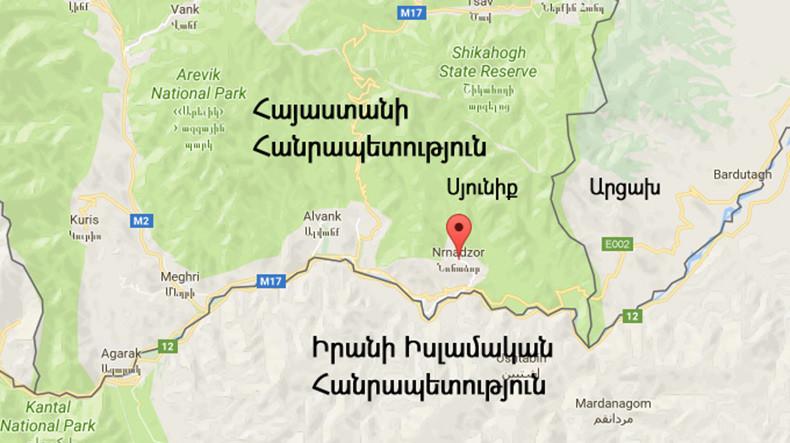
The 300-year project of the corridor through the territory of Armenia
Political scientist Stepan Hasan-Jalalyan writes: "As it is known, one of the endless demands presented by Azerbaijan to Armenia for the conclusion of a peace treaty between Armenia and the occupier and genocidal Azerbaijan is to provide a corridor to Azerbaijan through the Syunik Marz of the Republic of Armenia, through which the main part of the latter's territory will be connected by land, which is illegally under the jurisdiction of Azerbaijan, but historically and by law. by force with the Autonomous Republic of Nakhichevan belonging to Armenia and Turkey.
Taking into account the fact that the current Azerbaijan is a part of the Ottoman Turkish government in 1918 through the invasion of Transcaucasia by the Turkish army. The successor of the Republic of Azerbaijan, established on May 28, which took the name of Azerbaijan, located in the north-east of neighboring Iran, as the name of its own state and is not recognized internationally, we can claim that the idea of having a corridor through the Syunik region of the Republic of Armenia belongs to Azerbaijan, not an artificial, false entity. but to occupying and genocidal Turkey.
Accordingly, the corridor can be considered one of the first steps to achieve Turkey's main goal, that is, to dominate the coastal regions of the Caspian Sea, which will be followed over time by the complete occupation of Gegharkunik, Vayots Dzor and Syunik marzes of the Republic of Armenia and the genocide of the local Armenians.
It should be noted that the aforementioned main goal of Turkey has a history of several centuries. This is irrefutably evidenced by an almost 300-year-old document drawn up in Artsakh.
Thus, in 1725 On March 1, the first Turkish military unit, about 4,700 soldiers under the command of Shahin, Salah and Ali Pasha, invaded the Varanda province of Artsakh.
Catholicos of Artsakh, supreme commander of the Artsakh Melik troops, leader of the national liberation struggle Yesai Hasan-Jalalyan, demonstrating a flexible policy, orders to meet the Turkish military commanders with gifts and organize a reception worthy of an Artsakh citizen. Then Esa's patriarch offers the Turkish generals to be entertained in the villages of Artsakh, taking care of food and accommodation.
The Turkish command, which had already seen the strength of the Melik military forces of Artsakh many times and in turn avoided a clash with them, being very satisfied with such an outcome, gladly accepted the proposal of Yesa's patriarch.
The Turkish soldiers were divided into groups of 100, 200 and 300 in 33 Armenian villages and were fed well for two days. However, this was simply a well-prepared trap. At night, the Melik troops of Artsakh made a sudden attack and massacred almost everyone, including the two pashas, taking Salah Pasha prisoner. Only 150 people were saved. As a result of a successfully planned and implemented military operation, it is possible to free more than 200 Christian prisoners.
We learn about the details of this case from the 1725 report of the Catholicos of Artsakh Yesai Hasan-Jalalyan and the Meliks. from the letter sent to the Russian Emperor Peter I on March 10. "Now that our number is RHDH (1725) on the first of the month of March, sai ghoshun (troop - S.H.-J.) riding DREKH (4700) came over us, G(3) was a pasha, named after Shahin, Salah and Ali. We didn't see that there were too many of them, it wasn't by fighting, we went ahead and did some digging. we massacred, we also killed Pasha B (2). We have that Salah Pasha was kept alive, then one thousand (150) people fled to the mountain. BJ (200) be more Christian here, we freed you."
The Catholicos of Yesa and the meliks interrogated the captive Salah Pasha. The words of Turk Pasha during the interrogation are extremely remarkable and current.
Telling about their long-standing intention to eliminate the Armenian wedge between Ottoman Turkey and the Caspian Sea, Salah Pasha, in particular, said: "Our king ordered us to eliminate the Armenians. Before the troops of the Russian king come here, we will attack them (Armenians - S. H.-J.). Armenia should not exist and these countries should be destroyed in order to open our way, if you (Armenians - S.H.-J.) were not in our midst, we have now reached Derbend and Baku, which has been ours since ancient times."
These words, which belong to the general of the Turkish state, were said at the beginning of the 18th century, approximately 300 years before us. It is noteworthy, however, that they are still very modern today. Entering the 21st century, Turkey still operates according to the rules typical of the 18th century in its relations with various countries of the world, particularly Armenia. In fact, time has not made any corrections to Turkey's plans.
As we can see, Turkey's plan to genocide the Armenians and dominate the coastal regions of the Caspian Sea has a centuries-old history.
Thus, relying on an almost 300-year-old undeniable fact, we can claim that the author and real beneficiary of the idea of having a corridor through the Syunik Marz of the Republic of Armenia is not the occupying and genocidal Azerbaijan, but the occupying and genocidal Turkey."
Add new comment